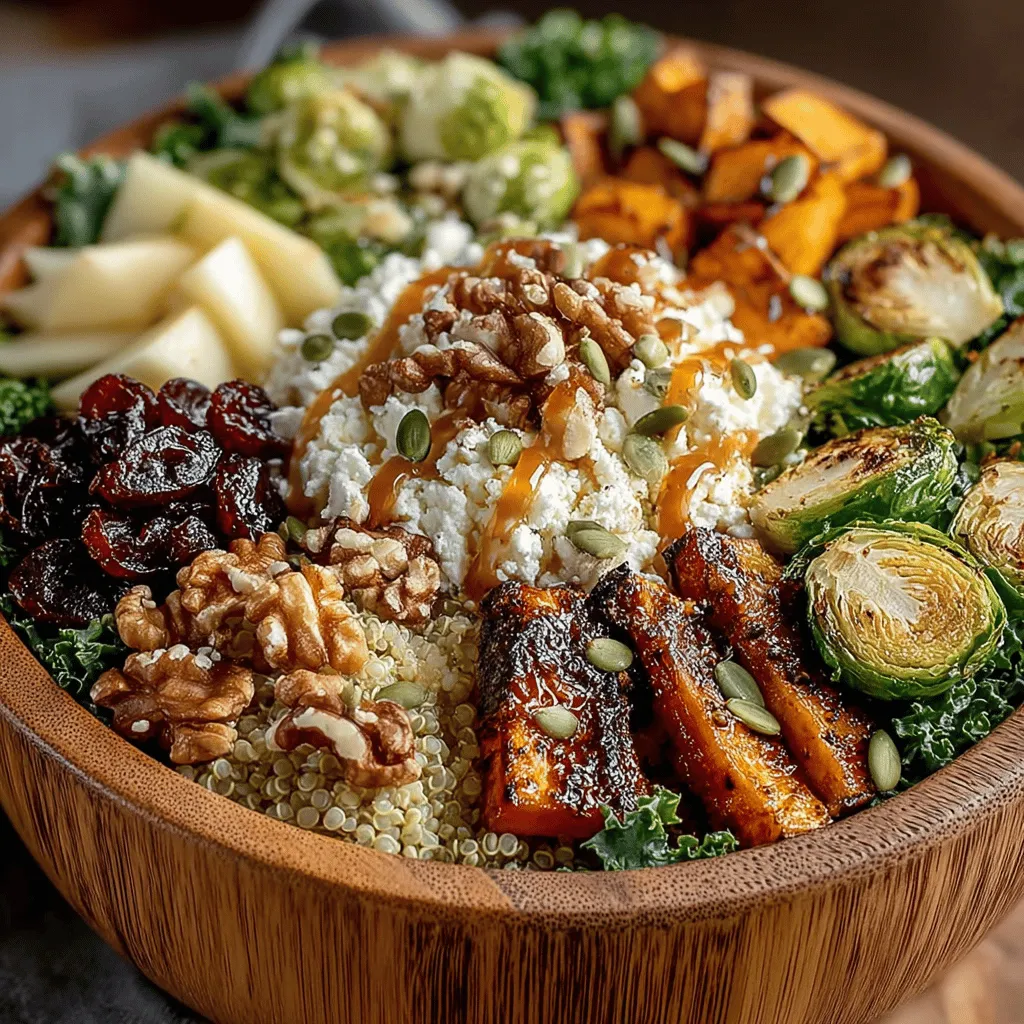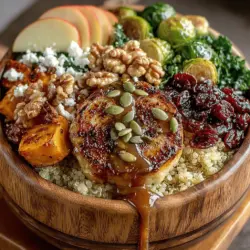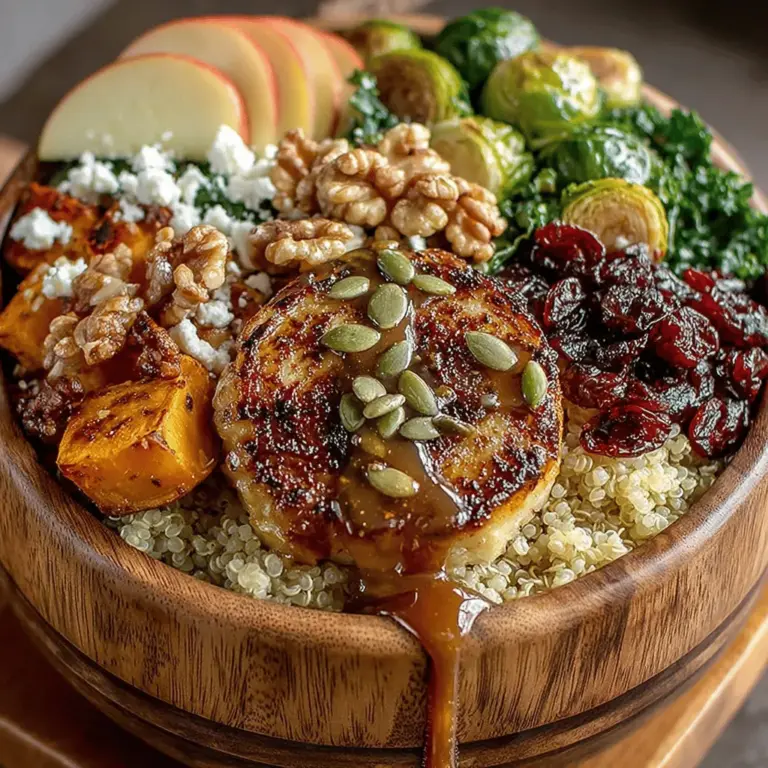Autumn Harvest Buddha Bowl: A Seasonal Delight
In recent years, Buddha bowls have surged in popularity, becoming a staple in health-conscious kitchens and trendy restaurants alike. These vibrant, nourishing dishes typically consist of a variety of ingredients arranged in a single bowl, offering a harmonious balance of flavors, textures, and nutrients. The Autumn Harvest Buddha Bowl is a perfect representation of this trend, showcasing the rich, warm flavors of the fall season through a colorful medley of fresh ingredients.
As the leaves change color and the air turns crisp, this bowl captures the essence of autumn with wholesome ingredients that not only celebrate the harvest but also provide a range of health benefits. With a base of quinoa, roasted sweet potatoes, and a mix of leafy greens, this dish is both satisfying and nutritious. Each ingredient is chosen not only for its flavor but also for its contribution to a balanced diet, making this Buddha bowl a perfect choice for anyone looking to embrace seasonal eating.
Understanding Buddha Bowls
At its core, a Buddha bowl is a combination of grains, proteins, vegetables, and often a dressing, all served together in one bowl. This concept allows for incredible versatility, enabling you to customize each bowl to suit your taste preferences, dietary needs, and seasonal availability of ingredients. Whether you’re vegan, vegetarian, or simply looking for a gluten-free meal, Buddha bowls can easily accommodate a variety of dietary choices, making them a popular option for meal preparation and healthy eating.
The trend of meal-prepping Buddha bowls has gained traction due to their convenience. Preparing a week’s worth of ingredients in advance allows for quick assembly during busy weekdays. Not only do these bowls save time, but they also promote mindful eating by encouraging individuals to incorporate wholesome, colorful foods into their diets, ultimately leading to better health outcomes.
Key Ingredients of the Autumn Harvest Buddha Bowl
Now that we have a grasp on the concept of Buddha bowls, let’s dive into the specific ingredients that make up the Autumn Harvest Buddha Bowl. Each component offers unique flavors and health benefits, making this dish a powerhouse of nutrition.
1. Quinoa: As the foundation of our Buddha bowl, quinoa is an excellent choice due to its high protein content and complete amino acid profile. This ancient grain is also rich in fiber, magnesium, and antioxidants, making it a nutritious base that provides sustained energy.
2. Sweet Potato: Known for its naturally sweet flavor and creamy texture, sweet potatoes are a fall favorite. They are rich in vitamins A and C, dietary fiber, and potassium. The natural sweetness of roasted sweet potatoes pairs beautifully with the savory elements of the dish, creating a delightful contrast.
3. Brussels Sprouts: These little green gems are nutrient-dense and particularly beneficial when roasted. Roasting Brussels sprouts enhances their flavor, bringing out a nutty sweetness that complements the other ingredients. They are high in vitamins K and C, as well as folate, making them a nutritious addition.
4. Kale: As a popular leafy green, kale is packed with vitamins A, C, and K, along with minerals like calcium and potassium. Its robust texture holds up well in a Buddha bowl, providing a crunchy element that balances the softer ingredients.
5. Apple: Incorporating seasonal apples into the bowl adds a refreshing crunch and a hint of sweetness. Apples are high in fiber and vitamin C, making them a healthy addition that enhances the overall flavor profile.
6. Dried Cranberries and Walnuts: These ingredients bring additional texture and bursts of flavor. Dried cranberries offer a tart contrast to the sweetness of the sweet potatoes, while walnuts add a satisfying crunch and healthy fats. Both ingredients provide antioxidants, which are beneficial for overall health.
7. Pumpkin Seeds: Also known as pepitas, pumpkin seeds add a delightful crunch and are a great source of magnesium, zinc, and healthy fats. Their nutty flavor complements the other ingredients beautifully.
8. Optional Cheese: For those who enjoy dairy, crumbled feta or goat cheese can be added for an extra layer of flavor. These cheeses provide creaminess and a salty kick that enhances the overall taste of the bowl.
Step-by-Step Cooking Instructions
Now that we’ve explored the key ingredients, it’s time to get started on creating your Autumn Harvest Buddha Bowl. The first steps are crucial for ensuring that everything cooks perfectly and comes together seamlessly.
Preheat the Oven: Begin by preheating your oven to 400°F (200°C). Preheating is essential for achieving even cooking, especially when roasting vegetables. It allows the sweet potatoes and Brussels sprouts to caramelize beautifully, enhancing their natural flavors.
Roasting the Sweet Potatoes and Brussels Sprouts: While the oven is heating up, prepare your sweet potatoes and Brussels sprouts. Start by washing and peeling the sweet potatoes, then cut them into bite-sized cubes. For the Brussels sprouts, trim the ends and slice them in half.
In a large mixing bowl, toss the sweet potatoes with a drizzle of olive oil, salt, and pepper. Spread them evenly on a baking sheet and place them in the oven. After about 15 minutes, add the halved Brussels sprouts to the same baking sheet, ensuring they are also coated with oil and seasoning. Return the baking sheet to the oven and roast for an additional 20-25 minutes, or until both the sweet potatoes and Brussels sprouts are tender and caramelized.
As you roast the vegetables, you can prepare the quinoa according to package instructions. Typically, this involves rinsing the quinoa, then cooking it in a pot with water or vegetable broth until it is fluffy and tender. This will serve as the hearty base for your Buddha bowl.
Once the vegetables are roasted and the quinoa is cooked, you’ll have a beautiful array of ingredients ready to assemble your Autumn Harvest Buddha Bowl, setting the stage for a delicious and nutritious meal that celebrates the flavors of the season.
Stay tuned for the next part of the recipe, where we’ll explore how to assemble the bowl and add the finishing touches that elevate this dish into a culinary masterpiece.

Cooking the Quinoa
To achieve the perfect texture for your quinoa, begin by rinsing one cup of quinoa under cold water in a fine-mesh sieve. This step is crucial as it removes the saponins, which can impart a bitter taste. After rinsing, transfer the quinoa to a medium saucepan and add two cups of water or vegetable broth for added flavor. Bring the mixture to a boil over medium-high heat.
Once boiling, reduce the heat to low, cover the saucepan, and let it simmer for about 15 minutes. You will know the quinoa is ready when all the water has been absorbed and the grains have expanded, becoming fluffy and translucent. Remove the saucepan from the heat and let it sit, still covered, for an additional 5 minutes. Fluff the quinoa with a fork before using it in your Buddha bowl. This method ensures that your quinoa has a light, airy texture that serves as a perfect base for the other ingredients.
Sautéing the Kale
Kale is a nutrient-dense leafy green that adds a vibrant color and a wealth of health benefits to your Buddha bowl. To prepare the kale, start by washing and drying it thoroughly. Remove the tough stems and tear the leaves into bite-sized pieces.
Heat a tablespoon of olive oil in a skillet over medium heat. Once the oil is hot, add the kale to the pan. Sauté the kale for about 2-3 minutes, stirring frequently until the leaves are wilted but still bright green. Season with a pinch of salt and a squeeze of lemon juice to enhance the flavor. The lemon juice not only adds a refreshing zing but also helps to balance the earthy flavors of the kale. This simple sautéing technique ensures the kale retains its nutrients while enhancing its taste and texture.
Preparing the Dressing
The dressing is the heart of any Buddha bowl, and for this autumn-inspired recipe, a delightful apple cider vinegar and maple syrup dressing is key. In a small bowl, whisk together three tablespoons of apple cider vinegar, two tablespoons of pure maple syrup, and a tablespoon of Dijon mustard. This combination creates a perfect balance of sweet and tangy, complementing the roasted vegetables and earthy quinoa.
Drizzle in a few tablespoons of olive oil while continuously whisking to emulsify the dressing. Taste and adjust the seasoning with salt and pepper according to your preference. This dressing not only enhances the flavors of the bowl but also adds a dose of health benefits, with apple cider vinegar known for its potential digestive and metabolic advantages.
Assembling the Buddha Bowl
When it comes to assembling your Autumn Harvest Buddha Bowl, presentation is just as important as flavor. Start with a generous scoop of quinoa as the base. Next, artfully layer the sautéed kale on one side, followed by the roasted sweet potatoes, Brussels sprouts, and any additional vegetables you’ve chosen, such as beets or carrots.
To elevate the visual appeal, consider arranging the ingredients in distinct sections rather than mixing them together. This not only looks beautiful but also allows for a delightful variety in each bite. Drizzle the prepared dressing over the top, and finish with a sprinkle of nuts or seeds for added crunch. Optional toppings, such as crumbled feta or goat cheese, can add a creamy texture and a burst of flavor, making each bite even more satisfying.
Optional Toppings
While the base recipe is delicious on its own, adding optional toppings can take your Autumn Harvest Buddha Bowl to the next level. For those looking for creaminess, a sprinkle of feta cheese or a dollop of tahini can enhance the dish’s richness. If you prefer plant-based options, consider adding sliced avocado for healthy fats or roasted chickpeas for added protein.
Other great options include pumpkin seeds for a nutty crunch or pomegranate seeds for a burst of sweetness and color. Experimenting with these toppings not only enhances the flavor but also adds nutritional benefits, making your bowl even more wholesome.
Nutritional Benefits of the Autumn Harvest Buddha Bowl
The Autumn Harvest Buddha Bowl is a powerhouse of nutrition, offering a well-rounded meal that incorporates various food groups. Here’s a breakdown of the health benefits of each ingredient:
– Quinoa: A complete protein source containing all nine essential amino acids, quinoa is also high in fiber and gluten-free.
– Kale: Rich in vitamins A, C, and K, kale is a great source of antioxidants and supports heart health.
– Sweet Potatoes: Packed with beta-carotene, fiber, and potassium, sweet potatoes offer a slow-release source of energy.
– Brussels Sprouts: High in fiber and vitamin C, these little cruciferous vegetables support digestion and immune function.
– Apple Cider Vinegar: Known for its potential health benefits, including blood sugar regulation and weight management.
– Maple Syrup: A natural sweetener that contains antioxidants and essential minerals like manganese and zinc.
When combined, these ingredients provide a balanced meal rich in carbohydrates, healthy fats, and proteins, making it perfect for those looking to maintain energy levels throughout the day. The inclusion of seasonal fruits and vegetables further enhances the antioxidant properties of the bowl, supporting overall health and wellness.
Serving Suggestions and Variations
The beauty of the Autumn Harvest Buddha Bowl is its versatility. You can serve it warm or at room temperature, making it ideal for meal prep or a cozy family dinner. For those who desire extra sustenance, consider adding protein sources like roasted chickpeas, grilled chicken, or tofu. Each addition brings its flavor profile and nutritional benefits, allowing for customization based on dietary preferences.
Feel free to experiment with alternative seasonal ingredients based on availability. For instance, swapping out sweet potatoes for roasted butternut squash or adding in seasonal fruits like apples or pears can create delightful variations. Don’t hesitate to get creative and make the bowl your own!
Culinary Tips for Perfecting Your Buddha Bowl
To enhance your preparation process and achieve the perfect Buddha bowl, consider the following culinary tips:
– Quality Kitchen Equipment: Invest in a good set of knives for efficient chopping and a reliable oven for roasting vegetables. These tools can significantly improve your cooking experience and results.
– Meal Prepping: Prepare the ingredients in advance for easy assembly during busy weekdays. Roasting vegetables, cooking quinoa, and making the dressing ahead of time can save you valuable time.
– Plating Techniques: Aim for a colorful presentation by using a variety of vegetables and toppings. Use bowls with a contrasting color to make the ingredients pop and arrange them in a way that showcases their textures. This will not only make your meal more visually appealing but will also enhance your dining experience.
Conclusion
The Autumn Harvest Buddha Bowl is more than just a meal; it’s a celebration of the flavors and colors of autumn. With its rich nutritional profile and delightful combination of textures and tastes, this dish embodies the essence of healthy eating.
Not only does it provide a balanced and wholesome meal, but it also encourages creativity in the kitchen. We invite you to experiment with your own variations and enjoy the seasonal bounty of ingredients that autumn has to offer. Whether you’re a seasoned chef or a novice in the kitchen, this Buddha bowl is sure to become a favorite in your culinary repertoire. Embrace the season, nourish your body, and enjoy the deliciousness of this vibrant dish!

